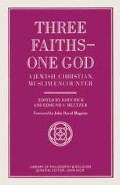Abstract
The central issue to be faced as we confront the doctrine of the Land in Jewish tradition is that we have been led to believe that as an historical religion Judaism manifests a marked preference for sacred time over sacred space. Having been nurtured by A. J. Heschel’s lyrical prose that declares unequivocally, ‘Judaism is a religion of time aiming at the sanctification of time … to the Bible it is holiness in time, the Sabbath, which comes first … The sanctity of the time came first, the sanctity of man came second, and the sanctity of space last. Time was hallowed by God; space, the Tabernacle, was consecrated by Moses’,1 we are astonished by the realisation that space occupies a far more prominent place in our theology than we were, heretofore, prone to admit. One must wonder aloud as to whether Heschel himself conceded this point by devoting one of his last books, Israel: An Echo of Eternity, to the Land. Beyond this concern with holy territory, we, children of modernity, are offended and alienated by the ‘scandal of particularity’ that emanates from the twin concepts of Jewish peoplehood and nationhood. Finally, our Christian brethren have, over the years, viewed the land-centred-ness of ‘Israel of the flesh’ with some considerable scepticism, especially when juxtaposed with the immaterial sanctity of ‘Israel of the spirit’.
Access this chapter
Tax calculation will be finalised at checkout
Purchases are for personal use only
Preview
Unable to display preview. Download preview PDF.
Notes and References
Consider, for example, the doctrine of shelilat hagolah (negation of the exile) that has been a consistent theme in Zionist thought.
D. Vital, The Origins of Zionism (Oxford: Clarendon Press, 1975) p.1.
James Sanders, Torah and Canon (Philadelphia: Fortress, 1972) pp. 25–48. Sanders’s observation is most interesting in light of the land-law dichotomy posited in the main body of the chapter. Perhaps the Torah is itself the best evidence of the inherent correctness of the RaMBaM-Hartman approach; the narrative description of the Kibbush is separated from the Torah and its laws.
Jacob Neusner, ‘Sympesium and the Territorial Dimension of Judaism’, Midstream (March 1983), pp. 38–9,
and ‘Map Without Territory: Mishna’s System of Sacrifice and Sanctuary’, History of Religions 19 (1979) pp. 103–27.
‘Map Without Territory’.
‘Map Without Territory’.
Avot d’Rabbi Natan, ch. 6.
Tanhuma, Vayera 1, Buber edn, p. 420.
B. T. Megillah 16b.
Neusner, ‘Map Without Territory’, p. 125.
Maggid Devarar l’Yaakov (Koretz) p. 9b quoted in G. Scholem, ‘Neutralization of Messianism in Early Hasidism’, The Messianic Idea in Judaism, and other essays on Jewish Spirituality (New York: Schocken, 1971), p. 201.
Degel Machaneh Ephraim (Jerusalem), pp. 135–6. A full discussion of this beautiful passage is to be found in Art Green, ‘Sabbath as Temple: Some Thoughts on Space and Time in Judaism’, in Go and Study: Essays Presented to Alfred Jospe, (edited by Raphael Jospe and Samuel C. Fishman (Washington, DC: B’nai B’rith Hillel Foundations, c. 1980) pp. 301–2.
Nachmanides, Commentary to Genesis 1:1, Charles Chavel, (trans.), pp. 17–20.
Nachmanides, Commentary to Genesis 1:1, pp. 17–20.
Commentary to Psalms, Mikraot Gedulot.
For a full discussion of all the issues pertaining to Nachmanides see Uriel Simon, ‘Religion, Morality and Politics’, in Forum.
Kedushat Levi (Warsaw) p. 5.
Although I argued above that Nachmanides’s relationship to the Land is that of the mythic-messianist, his mythically mystical inclinations cannot override the moral-ethical considerations of the law. He is, after all, thoroughly committed to Talmudic law and ethics.
Editor information
Editors and Affiliations
Copyright information
© 1989 Chaim Seidler-Feller
About this chapter
Cite this chapter
Seidler-Feller, C. (1989). The Land of Israel: Sanctified Matter or Mythic Space?. In: Hick, J., Meltzer, E.S. (eds) Three Faiths — One God. Library of Philosophy and Religion. Palgrave Macmillan, London. https://doi.org/10.1007/978-1-349-09434-9_15
Download citation
DOI: https://doi.org/10.1007/978-1-349-09434-9_15
Publisher Name: Palgrave Macmillan, London
Print ISBN: 978-1-349-09436-3
Online ISBN: 978-1-349-09434-9
eBook Packages: Palgrave Religion & Philosophy CollectionPhilosophy and Religion (R0)

